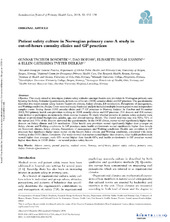| dc.description.abstract | Objective. This study aimed to investigate patient safety attitudes amongst health care providers in Norwegian primary care by using the Safety Attitudes Questionnaire, in both out-of-hours (OOH) casualty clinics and GP practices. The questionnaire identifies five major patient safety factors: Teamwork climate, Safety climate, Job satisfaction, Perceptions of management, and Working conditions. Design. Cross-sectional study. Statistical analysis included multiple linear regression and independent samples t-tests. Setting. Seven OOH casualty clinics and 17 GP practices in Norway. Subjects. In October and November 2012, 510 primary health care providers working in OOH casualty clinics and GP practices (316 doctors and 194 nurses) were invited to participate anonymously. Main outcome measures. To study whether patterns in patient safety attitudes were related to professional background, gender, age, and clinical setting. Results. The overall response rate was 52%; 72% of the nurses and 39% of the doctors answered the questionnaire. In the OOH clinics, nurses scored significantly higher than doctors on Safety climate and Job satisfaction. Older health care providers scored significantly higher than younger on Safety climate and Working conditions. In GP practices, male health professionals scored significantly higher than female on Teamwork climate, Safety climate, Perceptions of management and Working conditions. Health care providers in GP practices had significant higher mean scores on the factors Safety climate and Working conditions, compared with those working in the OOH clinics. Conclusion. Our study showed that nurses scored higher than doctors, older health professionals scored higher than younger, male GPs scored higher than female GPs, and health professionals in GP practices scored higher than those in OOH clinics – on several patient safety factors. | en_US |

